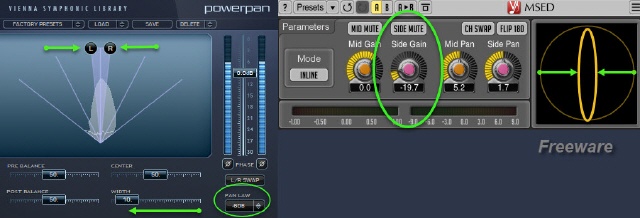Content / Inhalt

- English
- Deutsch
in general
Like this website, the tutorial is bilingual. Just like here, you can select your desired language via a tab. I have consciously chosen this form "Display next to each other". If someone speaks Spanish, he may not understand English text. If he has the German text visavis, that can help. Basically, the English text is always selected first.
Training Material

For all exercises and tasks, real sample audio files are available. Some of them are published and available on my Website, or they are attached to the tutorial. On the one hand these exercises consist of files of whole orchestral works, on the other hand they are special files, which I created especially for the exercises.
Solutions

All exercises contain a possible solution from me. These solutions are shown step by step with pictures, sound samples, videos or text. Every necessary action that leads to the solution can be easily understood. At the same time, the "path to solution" shown is again detailed learning material. But this time the theory is shown in practice. The solution also shows what you did differently. If your solution sounds better - great and congratulation !!!
Even if your DAW is not Cubase, you will not have trouble understanding the steps. You can certainly "recreate" the situations in your DAW.
>>> This kind of learning material, assignments and solutions is ideal. <<<
You can not get any closer to mixing an orchestra.
At the same time, the nature of this tutorial will give you the personal time you need to reproduce everything.
It is not a video that has to be stopped again and again ...
Tutorial - Format

The tutorial comes as html file. This means that you can move back and forth with links, play music, download, enlarge images - everything you are used to when visiting a website.
The design of the tutorial does not fit to the display like this one. With about 1440 pixels, your screen should be OK for using the tutorial. I chose this type of design because the tutorial should work around the world, even without the latest techniques. If you have the latest Firefox browser version (free), you can read the tutorial effortlessly.
Tutorial Content
Tutorial-Mixing-An-Orchestra-Content [187 KB]
Tutorial Flyer
tutorial_mixing_an_orchestra_flyer.pdf [1’484 KB] (English/German)
The main goal of the tutorial is to plan a virtual orchestra situation and to realise it acoustically transparent. Here, as an example, the string orchestra is in the foreground and the organ is more distant. This leads to a nice and transparent sound image where everything is easily audible. Of course, this requires a good knowledge of all the audio effects that ultimately help achieve the goal.
The tutorial offers everything necessary - even important convolution impulses.
G. F. Handel, Organ Concerto in F, HWV295
Generell
Wie diese Website, ist das Tutorial zweisprachig ausgeführt. Genau wie hier, können Sie über einen Reiter jeweils Ihre gewünschte Sprache wählen. Ich entschloss mich bewusst für diesen Weg vom "Nebeneinader". Wenn jemand Spanisch als Muttersprache hat, versteht er vielleicht einen Englischen Text nicht. Hat er den Deutschen Text gleich daneben, hilft dies vielleicht. Grundsätzlich ist zuerst immer der Englische Text angewählt.
Übungsmaterial

Für alle Übungen und Aufgaben stehen echte Sample-Audiofiles zur Verfügung. Zum Teil sind sie öffentlich auf meiner Website zu finden, oder sie sind dem Tutorial angehängt. Einerseits bestehen diese Übungen aus Files von ganzen Orchesterwerken, andererseits sind es spezielle Files, die ich jeweils extra für die entsprechenden Übungen herstellte.
Lösungen

Alle Übungen enthalten eine mögliche Lösung von mir. Diese Lösungen sind schrittweise aufgezeigt mit Bildern, Tonbeispielen, Videos oder mit Text. So kann jede nötige Handlung, die zur Lösung führt, nachvollzogen werden. Gleichzeitig ist der gezeigte "Weg zur Lösung" wiederum detailliertes Lernmaterial. Diesmal ist aber die Theorie in der Praxis gezeigt. Mit der Lösung sehen Sie auch, was Sie anders anpackten. Wenn es bei Ihnen besser tönt - toll, dann gratuliere ich Ihnen.
Auch wenn Ihre DAW nicht Cubase ist, werden Sie keine Mühe haben, die Schritte nachvollziehen zu können. Sie können die Situationen bestimmt in Ihrer DAW "nachzubauen".
>>> Diese Art von Lernmaterial, Aufgabestellungen und Lösungen ist ideal. <<<
Näher dran am Mischen eines Orchesters kann man nicht sein.
Gleichzeitig stellt die Art dieses Tutorials Ihre persönlich nötige Zeit zur Verfügung, um alles nachzuvollzienen.
Es ist kein Video, das immer wieder angehalten werden muss...
Tutorial - Format

Das Tutorial wird als html-Datei geliefert. Das heisst, Sie können sich mit Links hin und her bewegen, Musik abspielen, Dateien "herunter" laden/speichern Bilder vergrössern - eben alles, was man sich gewohnt ist bei einem Website-Besuch.
Das Design des Tutorials passt sich allerdings nicht an wie dieses hier. Mit etwa 1440 Pixeln sollte Ihr Bildschirm in der Breite auflösen können. Ich wählte dies so, weil das Tutorial auf der ganzen Welt - auch ohne die neusten Techniken - funktionieren soll. Wer die neuste Firefox-Browserversion hat (free), kann das Tutorial mühelos lesen.
Tutorial Inhalt
Tutorial-Mixing-An-Orchestra-Content [187 KB]
Tutorial Flyer
tutorial_mixing_an_orchestra_flyer.pdf [1’484 KB] (English/German)
Das Hauptziel des Tutorials ist es, eine virtuelle Orchestersituation zu planen und akustisch transparent zu realisieren. Als Beispiel steht hier das Streichorchester im Vordergrund und die Orgel ist weiter entfernt - ähnlich wie in der Realität. Dies führt zu einem schönen und transparenten Klangbild, bei dem alles gut hörbar ist. Das erfordert natürlich eine gute Kenntnis aller Audioeffekte, die letztlich helfen, das Ziel zu erreichen.
Das Tutorial bietet alles nötige - sogar wichtige Convolution-Impulse.
G. F. Handel, Organ Concerto in F, HWV295
Please Select for even more Info...
Back to www.beat-kaufmann.com


